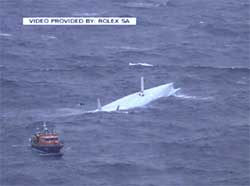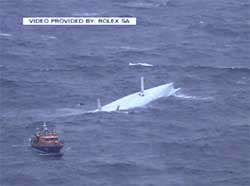 NARRAGANSETT, R.I. – August 18, 2011 – SARMAP, a search and rescue mapping software program developed by a University of Rhode Island professor and colleagues at a company he founded, was instrumental in the efforts to locate and rescue five crewmembers of a yacht that capsized during a race off the coast of Ireland earlier this week.
NARRAGANSETT, R.I. – August 18, 2011 – SARMAP, a search and rescue mapping software program developed by a University of Rhode Island professor and colleagues at a company he founded, was instrumental in the efforts to locate and rescue five crewmembers of a yacht that capsized during a race off the coast of Ireland earlier this week.
According to URI Ocean Engineering Professor Malcolm Spaulding, SARMAP provides rapid predictions of the movement of drifting objects and missing persons at sea. The software provides search patterns and calculates the probability of containment, probability of detection, and probability of success.
“I’ve been involved in the search and rescue business since the late 1970s,” said Spaulding, who started the Wakefield-based Applied Science Associates in 1979 to further develop and market his software applications. “It’s an outgrowth of an oil spill transport prediction model I developed that uses the same underlying physics and is based on ocean currents and winds.”
The sailing accident occurred during the biennial Rolex Fastnet Race, an international yacht race that spans from the Isle of Wight, around Fastnet Rock off Ireland’s southwest coast and on to Plymouth in the south of England. Shortly after rounding the Fastnet Rock, the keel of the 100-foot long Rambler 100 broke off and the yacht overturned, leaving 16 crewmembers clinging to the hull while five others were swept out to sea. Several members of the crew have ties to Rhode Island.
The personal locator beacon on the Rambler 100 was activated when the yacht overturned, quickly alerting rescuers to the location of the 16 stranded crewmembers still with the vessel, but recovering the five lost at sea required a more advanced approach.
The Irish Coast Guard, which has a fifteen-year-long working relationship with Applied Science Associates, employed SARMAP’s sophisticated tracking capabilities to rapidly predict the movement of the drifting survivors and calculate a precise search area.
Chris Reynolds, head of the Irish Coast Guard, said that the software, which uses a combination of GIS (geographic information system), a database of drift behavior, real-time environmental information and powerful computer modeling to extrapolate the location of vessels, people, or containers adrift at sea, was “invaluable” to the rescue efforts in the rough and foggy coastal waters.
ASA President Eoin Howlett said after the rescue. “We have worked with the Irish Coast Guard successfully for many years. They are an innovative agency and have a history of implementing the latest in ocean technologies. We are very pleased that our software, combined with their rapid decision-making, resulted in such a positive outcome.”
PICTURED ABOVE:
SARMAP, a search and rescue mapping software program created by University of Rhode Island professor Malcolm Spaulding, was instrumental in the rescue of five crewmembers of the Rambler 100, a yacht that capsized this week during the Rolex Fastnet Race off the coast of Ireland. (Photo courtesy of Rolex SA video)

